Exploring Dinosaur Artifacts: A Collector's Guide
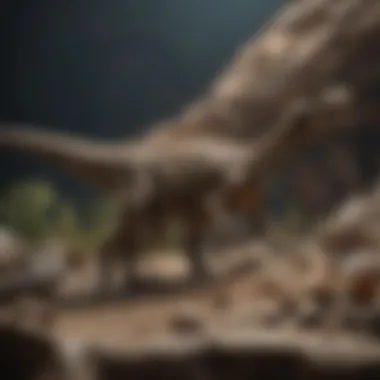
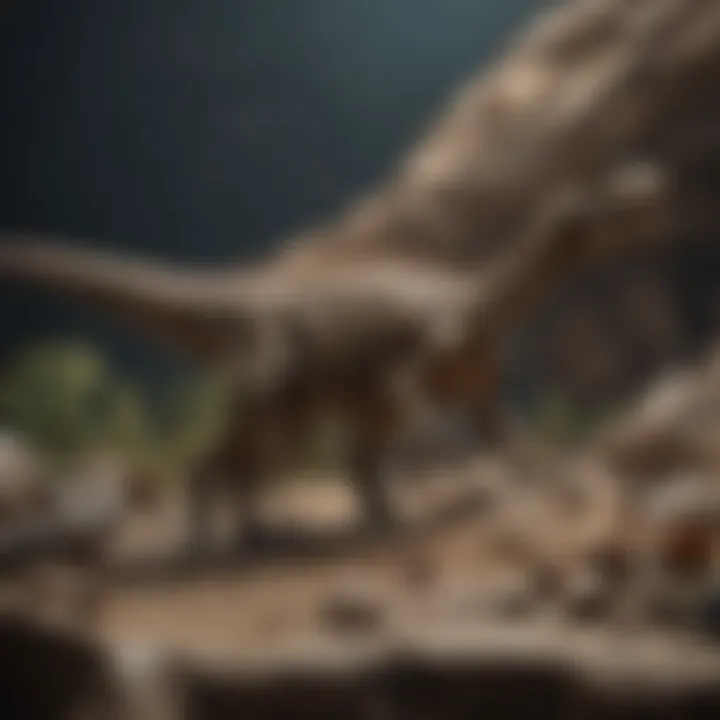
Intro
The allure of dinosaur artifacts stretches beyond mere aesthetic appeal; it's a fascinating intersection of history, science, and passion. Collectors, enthusiasts, and even casual onlookers find themselves drawn into the captivating world of paleontological treasures. With each fossil or replica, there’s a story waiting to be uncovered, one that adds layers to our understanding of life millions of years ago. As the market for these collectibles burgeons, it’s essential for potential buyers to navigate this landscape with knowledge and awareness.
The following exploration will illuminate the various types of dinosaur artifacts available for sale, provide insights into their value, and highlight the ethical considerations that come with collecting. This understanding is crucial for anyone wishing to engage in the practice, ensuring they do so responsibly. Moreover, through platforms like FossilNest, community engagement enriches the experience, fostering a culture of appreciation around these remarkable artifacts.
Featured Collectible of the Month
Overview
In this month’s spotlight is the Hadrosaur Footprint. These unique finds are not only visually striking but also hold a treasure trove of information about the behaviors and environments of these ancient creatures. Footprints such as these capture a moment in time – a fleeting glimpse into the life of hadrosaurs as they roamed the Earth. Collectors value these artifacts for their rarity and the stories they tell.
Historical Significance
The Hadrosaur Footprint provides significant insights into the behaviors and migratory paths of these dinosaurs. Each strike left behind tells scientists about the terrain, climate, and social interactions of hadrosaurs. From a collector’s standpoint, owning a footprint deepens one's connection to the past, transforming a simple fossil into a conversation starter about life during the Late Cretaceous period.
"Each footprint is a personal connection; it’s like holding onto a piece of history that spans eons."
Identification Techniques
Understanding how to identify different dinosaur artifacts can enhance your collecting experience, ensuring that what you buy is authentic and valuable.
Visual Characteristics
When examining dinosaur fossils, close attention to detail is crucial. Here are some features to consider:
- Texture: Many fossils exhibit a unique texture that reflects their age.
- Coloration: Different minerals present during fossilization can lead to varied coloration.
- Size and Shape: Collectors should be aware of the typical sizes and shapes for each species to authenticate their finds.
Resources for Identification
If you’re unsure about an artifact’s authenticity or want to learn more about it, various resources can assist:
- Wikipedia
- Britannica
- Fossil and Rock Collectors Community on Reddit
- Facebook Groups for Collectors
By utilizing these resources, collectors would find helpful tips and the opportunity to engage with experienced individuals in the field, enhancing their understanding and appreciation for their artifacts. This endeavor not only elevates personal collections but also contributes to a broader community of dinosaur enthusiasts.
The Allure of Dinosaur Artifacts
Dinosaur artifacts have this genuine pull, a magnetism that captivates enthusiasts far and wide. Think about it: these remnants tell the tales of creatures that roamed the Earth millions of years ago. They spark a sense of wonder and curiosity, appealing to both seasoned collectors and casual observers alike. When you stumble upon a dinosaur fossil or a beautiful replica, it can almost whisper the secrets of prehistoric life. The journey of finding these artifacts can take you through time, bridging the gap between the modern world and an age long forgotten.
The allure doesn’t just stem from the age or the aesthetics; it’s also about the stories behind each piece. Each artifact carries its own narrative - how it was formed, where it was found, and the significance it holds in understanding Earth’s history. For many collectors, acquiring these items becomes a quest for knowledge as much as a passion for collecting.
Understanding Collectibles
In the realm of collecting, dinosaur artifacts occupy a unique niche. Collectibles vary widely, ranging from coins to stamps, but what sets dinosaur fossils and related items apart is their inherent rarity and educational value. The thrill of the hunt is heightened by the challenge: not only are genuine fossils rare, but discerning authentic pieces from replicas involves a knowledge base that few possess.
When someone invests time and resources into collecting dinosaur artifacts, they often become part of a community that appreciates both the item and the vast history it represents. With communities sprouting up on platforms such as Reddit and groups on Facebook, there's a robust support system for collectors. This interconnectedness plays a significant role in the appreciation of these artifacts, as members share tips, field experiences, and even sources for acquiring new additions.
Significance in Paleontology
Dinosaur artifacts are not merely collectibles; they are also essential to the field of paleontology. These items provide the scientific community with invaluable insights into the lives, behaviors, and environments of dinosaurs. Fossils can reveal a great deal about not just the species that occupied the Earth but also about climate changes and ecological shifts over millennia. By studying these artifacts, paleontologists piece together the great puzzle of life’s history on our planet.
Additionally, as collectors acquire and sometimes donate these artifacts to museums, they further potentiates research and public education. The interaction between collectors and scientists can thus enrich both the private collection world and public knowledge. Each artifact serves as a tangible link to the planet’s distant past, contributing to ongoing studies and increasing awareness of paleontological research.
"To find a dinosaur fossil is akin to holding a piece of history in the palm of your hand. It invites contemplation and awe."
Types of Dinosaur Artifacts Available for Sale
When it comes to the realm of dinosaur collectibles, the options can be overwhelming and seem near infinite. However, understanding the type of dinosaur artifacts available is essential for any collector, whether you're just starting out or you're a seasoned veteran. Each type provides not just aesthetic value but also educational and sentimental significance. Here, we will break down some of the major categories of dinosaur artifacts you might come across, spotlighting their unique traits and considerations.
Fossils: The Backbone of Collections
Fossils transcend mere collectibles; they serve as tangible connections to a distant past. As the untouched remains of ancient organisms, fossils are often viewed as the crown jewels in a collector’s treasure trove. These include bones, teeth, footprints, and even full skeletons that shed light on the world that existed millions of years ago. Each fossil has its own tale, revealing clues about the creatures themselves as well as the environments they inhabited.
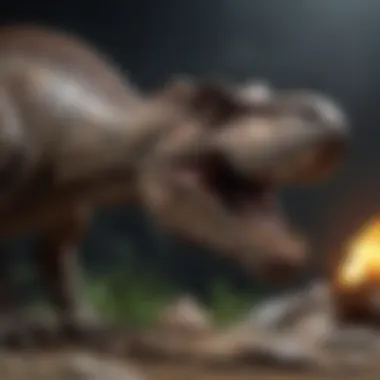
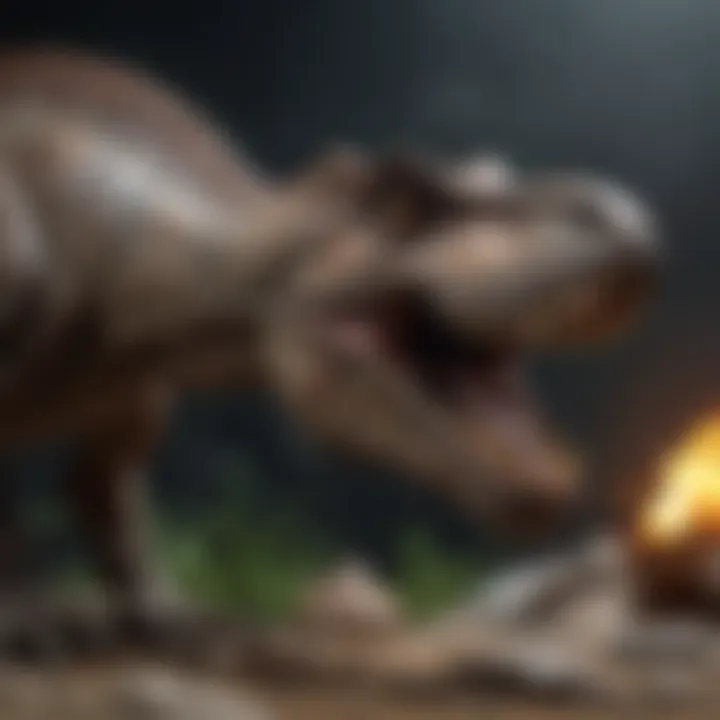
A few factors make fossils stand out:
- Scientific Value: Authentic fossils are crucial for researchers and paleontologists who strive to uncover the mysteries of prehistoric life. By acquiring fossils, collectors actively contribute to the understanding of our planet's biological history.
- Rarity and Demand: Certain fossils, like those from T. rex or Triceratops, can fetch astronomical prices at auctions. Their rarity creates a dynamic market, making catching these fossils a thrilling chase.
- Preservation Requirements: Fossils need careful handling and preservation. Many collectors learn the ropes of fossil conservation to maintain the integrity of their prized pieces.
"Fossils are not just relics of the past; they hold stories that can reshape our understanding of life."
Reproductions and Models
While genuine fossils often steal the spotlight, reproductions and artistic models have carved out their own niche in the world of collectibles. These pieces provide an accessible way for enthusiasts to engage with paleontological themes without the hefty price tag attached to originals. Reproductions can include 3D-printed dinosaur bones, lifelike models, or even home décor featuring prehistoric motifs.
Consider the following advantages of reproductions:
- Affordability: They are typically much cheaper compared to genuine fossils, making them a great option for younger collectors or enthusiasts on a tight budget.
- Educational Potential: Models can serve as excellent educational tools, simplifying complex concepts about dinosaur anatomy and behavior for schools and families alike.
- Aesthetic Variety: Many artists design striking pieces, which allows collectors to curate a visually appealing display in their homes or classrooms.
Educational Material and Literature
In today’s digital age, educational material about dinosaurs can be found across various platforms. Yet, physical books, journals, and magazines retain a unique charm and importance in any collection. Books can range from illustrated children’s stories to in-depth analyses of paleontological theories.
Incorporating educational literature can:
- Enhance Knowledge: Reading helps collectors deepen their understanding of dinosaurs, enabling them to make informed decisions when purchasing artifacts.
- Preserve History: Collectible books about dinosaurs often document significant discoveries, serving as a capsule of historical information that can be an incredible addition to any collection.
- Engage in the Community: Joining discussion groups or book clubs centered around paleontology can foster connections among like-minded individuals, enriching the overall collecting experience.
As you venture into the diverse world of dinosaur artifacts, it is essential to ask questions, dig deep into the specifics, and choose items that resonate with you. There's a wealth of options that not only enhance collections but can also ignite a passion for prehistoric worlds.
Where to Find Dinosaur Artifacts
When it comes to collecting dinosaur artifacts, knowing where to look can make all the difference between finding a treasure and striking out. The market is quite diverse, with various platforms offering distinct advantages and potential pitfalls. Navigating these options thoughtfully not only enhances your collecting experience but also helps you build a more impressive collection. In this section, we’ll explore three main avenues for sourcing these fascinating relics: online marketplaces, auction houses, and specialty shops or shows. Each has unique characteristics that can impact not just the acquisition process, but the overall value and authenticity of the items you may find.
Online Marketplaces
Online marketplaces have revolutionized the way collectors acquire dinosaur artifacts. Platforms like eBay and various specialized websites offer a seemingly endless selection of fossils, replicas, and educational material. The convenience of browsing listings from the comfort of your home cannot be overstated. Yet, this convenience comes with its own challenges.
One must be vigilant in assessing the credibility of sellers. Look for detailed photographs and transparent descriptions. Read feedback from previous buyers as well. A few tips for navigating these digital spaces include:
- Beware of low prices: If something seems too good to be true, it often is. Be skeptical of deals that sound like a steal.
- Check seller ratings: Reliable sellers generally have positive reviews and a history of satisfied customers.
- Ask questions: Don't hesitate to inquire about the item’s provenance or authenticity. A reputable seller should welcome queries and provide thorough answers.
Finding treasures online can be an exhilarating experience, but more often than not, you need to approach it with caution.
Auction Houses
Auction houses such as Sotheby's or Bonhams have a longstanding reputation for dealing in rare and valuable items, including dinosaur artifacts. These venues offer a platform for both buying and selling while providing a layer of vetting that online platforms might lack. When you walk into an auction, you’re stepping into a world where items come with measured histories and assessed values.
Here are a few reasons why auction houses can be appealing:
- Authentication process: Many auction houses conduct their own evaluations to ensure the authenticity of items before they enter the marketplace.
- Expert guidance: You can often consult with experts who understand the nuances of paleontological items, which can be incredibly helpful if you're a newbie.
- Unique finds: Auctions frequently feature items that aren’t available anywhere else, making it a goldmine for collectors looking for something special.
However, attending an auction can be intimidating, especially if you're new to it. It's essential to do your homework ahead of time, familiarize yourself with bidding processes, and be ready for the competitive atmosphere.
Specialty Shops and Shows
Specialty shops and fossil shows present another excellent opportunity for finding dinosaur artifacts. Whether a quaint shop tucked away in a small town or a massive convention showcasing the latest discoveries, these settings provide a chance for face-to-face interactions that you just can't replicate online.
Benefits of visiting these venues include:
- Personal connection: Meeting fellow collectors and sellers can lead to valuable alliances and friendships.
- Direct assessment: You can physically inspect items and gauge their quality, which is a huge advantage over online purchasing.
- Education opportunities: Many shows host talks and presentations where you can learn about new findings and preservation techniques.
These venues not only cater to seasoned collectors but also serve as an entry point for newcomers eager to learn. Engaging with the community and experiencing the artifacts firsthand enriches the collection process.
Assessing the Value of Dinosaur Artifacts
Understanding the value of dinosaur artifacts is crucial for collectors and enthusiasts alike. Knowing the worth of a piece can influence purchasing decisions, impact investment strategies, and shape collections in significant ways. With so many factors at play, it becomes essential to examine what drives these values and how collectors can make informed choices. Whether you're holding a fossilized bone or a beautifully crafted replica, understanding what lies beneath the surface of these treasures enhances the overall collecting experience.
Factors Influencing Value
When it comes to assessing the value of dinosaur artifacts, several key elements come into play:
- Rarity: The uniqueness of an artifact inherently increases its value. A one-of-a-kind specimen, for instance, will draw much more interest than more commonly available pieces.
- Condition: An artifact in pristine condition is worth more than one that has been damaged, repaired, or poorly preserved.
- Provenance: The history of an artifact - where it was found, how it was acquired, and any notable past ownership - adds layers of value and interest.
- Scientific Significance: Pieces that contribute meaningfully to paleontological research tend to attract higher prices among serious collectors.
- Market Demand: Just like any other market, supply and demand shapes the prices of dinosaur artifacts. Trends in the collector community can spike interest in certain types of artifacts, thus raising their value.
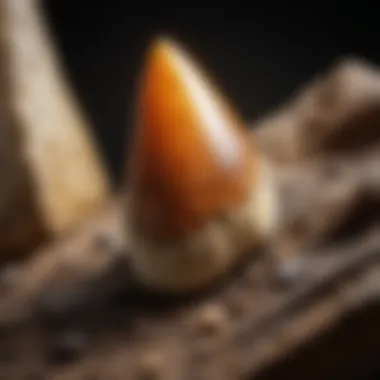
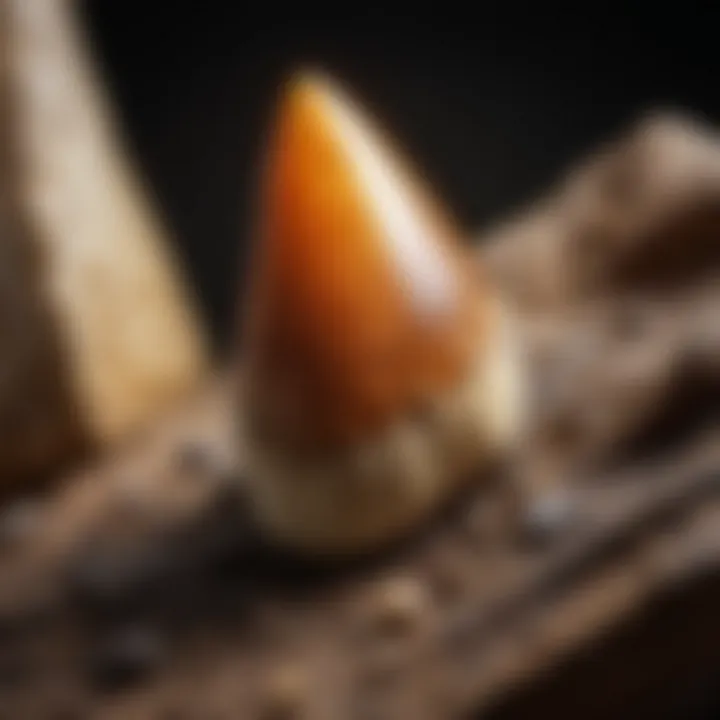
While experts may debate the relative weight of each factor, collectors benefit from taking a holistic approach when evaluating potential purchases.
Market Trends
The market for dinosaur artifacts is dynamic, reflecting both cultural attitudes and scientific advancements. Understanding these trends helps collectors navigate their purchases. Some current trends affecting values include:
- Increased Interest in Paleontology: A growing fascination with dinosaurs, especially among younger audiences, fuels demand. Documentaries, movies, and educational programs play roles in turning attention towards artifacts.
- Digital Platforms: Online galleries and auction sites have opened new avenues for buying and selling. This shift often leads to increased competition, which can drive up prices for desirable items.
- Investment Potential: More collectors are viewing dinosaur artifacts not just as collectibles but as investment opportunities. This mindset tends to inflate values, especially for unique specimens with sound provenance.
Keeping a pulse on these trends allows collectors to determine the best times to invest and realize the value of their artifacts.
Comparative Analysis with Other Collectibles
When juxtaposing dinosaur artifacts with other types of collectibles, such as contemporary art or rare coins, a few notable distinctions emerge:
- Emotional Connection: While art typically evokes aesthetic appreciation, many collectors find a deeper emotional connection to dinosaur artifacts—considering them fragments of history and reminders of Earth’s prehistoric wonders.
- Market Age and Stability: Other collectibles have more established market trends and valuation methods, giving collectors a wealth of data to analyze. In contrast, the market for dinosaur artifacts is still evolving and can be less predictable.
- Regulatory Considerations: Unlike many other collectibles, the acquisition of dinosaur artifacts often comes with significant ethical and legal considerations. Buyers must be vigilant about sourcing and the legality surrounding prehistoric bones and fossils.
In the end, understanding these differences expands the horizon for collectors, helping them to appreciate the unique journey that collecting dinosaur artifacts entails.
Authenticity and Provenance
In the world of collectibles, especially when it comes to something as fascinating as dinosaur artifacts, the notions of authenticity and provenance become vital. Ensuring that what you have is genuinely what it claims to be isn't just a matter of bragging rights; it’s about upholding the integrity of the field and fostering a responsible collecting culture.
Understanding Authenticity
So, what exactly do we mean when we talk about authenticity in relation to dinosaur artifacts? Essentially, authenticity refers to the genuineness of an item. In the context of fossils and other artifacts, it means confirming that the piece is real and hasn’t been altered or enhanced in ways that mislead collectors or researchers.
For instance, imagine you stumble upon a purported T-rex tooth at a local fair, being sold for a fraction of the price you'd expect. It can be tempting to scoop it up, but without proper verification, you might end up with a replica masquerading as the real deal.
Being able to distinguish between the real McCoy and a cleverly crafted imitation requires knowledge. Some ways to evaluate authenticity include:
- Visual Inspection: Experienced collectors know to look for signs of wear, natural markings, and color variations that might denote a genuine artifact.
- Scientific Analysis: Advanced methods, like carbon dating or isotopic analysis, can substantiate age and origin.
- Expert Appraisal: Bringing in a specialist can help connect the dots in terms of authenticity and make or break a collection.
Documentation and Certification
Now, let’s talk documents. They’re the unsung heroes in establishing an item’s legitimacy. When buying dinosaur artifacts, especially fossils, documentation serves as the backbone of proof. One prominent aspect of this involves certificates of authenticity (COA).
Certificates are formal documents that verify the origin, age, and sometimes the location where the fossil was found. A good COA will usually:
- Provide Detailed Descriptions: It often includes specifics about the fossil, its scientific significance, and any notable historical context.
- Detail the Previous Ownership: Provenance matters! Knowing the chain of custody can shed light on the legitimacy of the artifact.
- Include Expert Signatures: Authenticity backed by professionals in paleontology adds a layer of credibility.
Keep in mind that not having a COA doesn't automatically mean a fossil is a fake. Yet the presence of verified documentation can alleviate a range of concerns about potential pitfalls in the marketplace. Always ask before you commit: "What’s the story behind this piece?"
"Ensuring authenticity isn't just about the transaction; it's about creating a responsible collecting community that values history and science."
In short, navigating the intricate realm of dinosaur artifacts demands not only a discerning eye but also a commitment to seeking out comprehensive documentation and certification. With the right approach and a bit of patience, you can ensure that your collection stands its ground against any future scrutiny.
Ethical Considerations in Buying Artifacts
When it comes to acquiring dinosaur artifacts, ethics cannot just be swept under the rug. Collectors often face a myriad of dilemmas in this realm. It's not only about the thrill of finding a fossil or a rare artifact; it's also about the moral responsibility that comes with collecting. Engaging with this topic means acknowledging that the lines between legitimate collection and unethical acquisition can sometimes blur. Understandably, many collectors delve into this realm because the allure is strong, but navigating these waters requires a thoughtful approach.
Legal Framework
The legal landscape surrounding the acquisition of dinosaur artifacts can resemble a tangled web, often varying significantly by region. In some countries, certain fossils are entirely off-limits to collectors, while others may necessitate permits for legal collection. Laws like the Endangered Species Act and the Archaeological Resources Protection Act highlight the necessity of proper channels for selling and purchasing these artifacts. Ignoring these laws can lead to staggering fines or even criminal charges.
Collectors should take it upon themselves to be well versed in these regulations. It’s imperative to understand not just the local laws but the international ones as well. For instance, some fossils may be deemed cultural heritage, which means that they cannot be traded or sold without specific permissions. Staying informed helps not only in legal matters but also in fostering a culture of responsible collecting.
"Knowledge is power, especially when navigating the complex legal terrain surrounding fossil acquisition."
The Role of Conservation
Conservation plays a pivotal role in the ethics of dinosaur artifact acquisition. It's not just about securing a beautiful piece for a collection—it's also about understanding the impact that artifact collection can have on natural history and environments. When fossils are removed from their natural settings, they can lose their context, which is crucial for scientific study.
Collectors are encouraged to embrace conservation practices, not just for legal compliance but also for the integrity of the field. One effective way to do this is to consider alternatives to acquiring original fossils. Reproductions or educational materials can serve as excellent substitutes for those eager to gain a deeper understanding without risking harm to existing natural resources. Such approaches elevate the collector's role from merely a hoarder of objects to being a steward of history.
In summary, navigating the ethical landscape in buying dinosaur artifacts is essential for both passionate collectors and the broader scientific community. By adhering to legal requirements and embracing conservation efforts, collectors can ensure that their pursuits contribute positively to the world of paleontology.
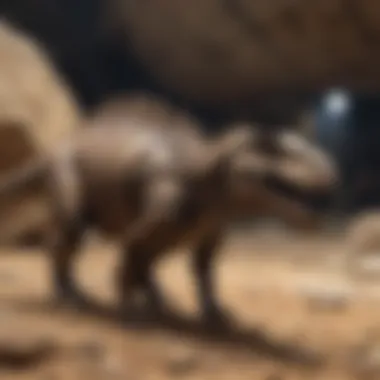
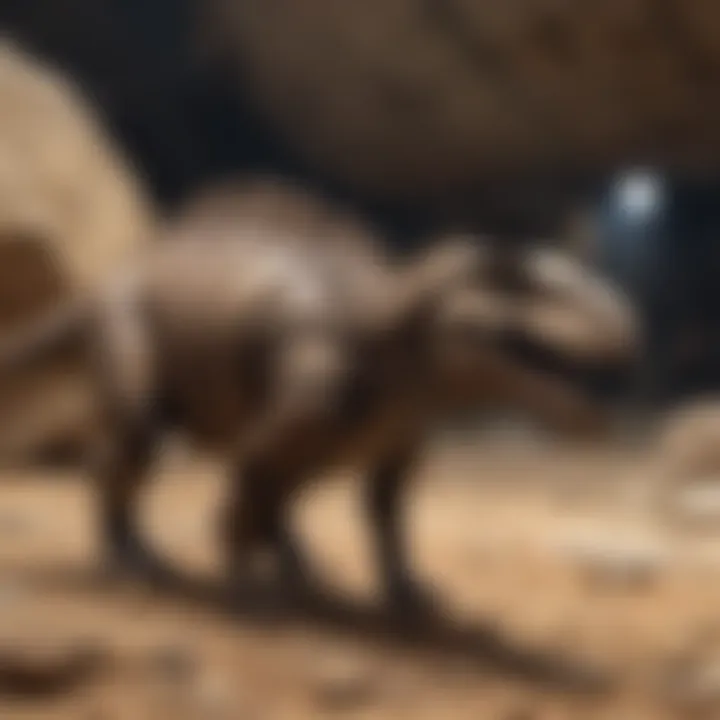
Care and Preservation of Dinosaur Artifacts
When it comes to collecting dinosaur artifacts, one cannot underestimate the significance of care and preservation. These relics of the past aren't just pieces of history; they are fragile embodiments of ancient life that require specific attention. By implementing proper care routines, collectors ensure that these treasures are maintained in a condition that honors their historical value and allows future generations to appreciate them.
From fossils to replicas, most dinosaur artifacts have unique materials that can react poorly to environmental conditions. Therefore, understanding effective storage methods and maintenance tips is essential for anyone keen on preserving these extraordinary pieces. The benefits are manifold: it not only helps in retaining the artifacts’ value but also extends their lifespan, allowing you to enjoy them for years to come.
Storage Recommendations
Proper storage goes a long way in safeguarding dinosaur artifacts from damage. Here are some key recommendations:
- Climate Control: Dinosaur artifacts are often sensitive to temperature and humidity changes. It's best to store them in a controlled environment—ideally, a cool, dry place. A temperature range of 60-70°F with humidity levels below 50% works well for most artifacts.
- Display Cases: When showcasing your collection, opt for display cases made of archival-quality materials. Acrylic or glass cases that block UV light not only enhance visibility but also provide a barrier against dust and physical contact.
- Padding and Support: Use soft padding materials within your display case or storage area. Avoid direct contact with hard surfaces since pressure can crack delicate fossils. Additionally, support larger specimens appropriately to prevent breakage or bending.
- Avoiding Chemicals: Steer clear of standard household cleaners. Some chemicals can react negatively with artifacts over time. Instead, use gentle, pH-balanced cleaning solutions.
Adhering to these recommendations can make all the difference when it comes to preserving your prized collections. Remember, the ultimate goal is not just to store these artifacts, but to respect their longstanding legacy.
Cleaning and Maintenance Tips
Cleaning dinosaur artifacts requires a careful touch. Here are a few tips to maintain their integrity while keeping them looking their best:
- Regular Dusting: Keep dust at bay by using a soft, microfiber cloth to dust your artifacts regularly. Avoid feather dusters or cloths that might scratch the surface.
- Gentle Cleaning: For stubborn grime, use a soft brush, like a paintbrush with natural bristles. Avoid using scrubbing motions; a light touch is essential to prevent surface wear.
- Inspect for Damage: Regularly check for cracks or other damages. Early detection allows for preventative measures or repairs to be made before the situation worsens.
- Proper Handling: Wash your hands before handling any fossils or artifacts. Oils from your skin can cause damage when left on delicate surfaces.
- Professional Help for Restorations: If repairs are needed, consider consulting a professional conservator who specializes in paleontological artifacts. They’ve the right tools and knowledge to restore delicately without causing further harm.
In summary, taking the time and care in storage and cleaning will go a long way. By ensuring proper preservation, collectors not only enhance the value and appearance of their artifacts but also contribute to the broader discipline of paleontological study.
"Proper care of artifacts is not merely a guideline; it's a commitment to preserving history for future generations."
This attention to detail demonstrates a collector's respect for the past and passion for knowledge that extends beyond mere ownership.
Community Engagement at FossilNest
Engaging with the community at FossilNest is vital for anyone interested in dinosaur artifacts. This platform isn't just a marketplace; it is a thriving hub for enthusiasts, collectors, and experts alike. By connecting with like-minded individuals, collectors gain insights that can significantly enhance their experience while navigating the intricate world of paleontology.
Benefits of Community Engagement
Being part of the FossilNest community provides numerous advantages:
- Shared Knowledge: Collectors share their experiences, tips, and best practices. This exchange of information helps newcomers avoid pitfalls and make more informed choices.
- Networking Opportunities: Making connections can lead to partnerships, trade opportunities, or even collaborative research ventures. Knowing the right people often opens doors that would otherwise remain closed.
- Emotional Support: Collecting can sometimes feel overwhelming, especially with issues like authenticity verification or dealing with market fluctuations. Engaging with a supportive community can provide much-needed encouragement.
Active engagement can enrich one's journey as a collector. Sharing success stories or challenges helps foster a sense of belonging. It's not just about what you have; it’s about who you know and what you learn from them.
Joining the Collectors' Network
FossilNest offers a well-structured collectors’ network that serves as a prime resource for anyone serious about their collection. Joining this network means stepping into a world brimming with opportunities.
- Expert Insights: The collective experience within the network allows members to tap into expert insights about various aspects of collecting. From identifying rare fossils to understanding preservation techniques, you’ll find that the knowledge accumulated within the community can’t be found in textbooks.
- Resource Sharing: Members share access to resources, whether it's information on where to find specific artifacts or recommended trusted sellers. This interconnectedness promotes a culture of collaboration.
- Mentoring Opportunities: New collectors can find mentors who guide them through the complexities of the market and offer personal insights based on their experiences.
Engaging with the network can improve one’s overall understanding and appreciation for the craft. Whether you’re a seasoned collector or a novice, participation in discussions or seeking advice can really amplify your collecting journey.
Participating in Events and Forums
Participation in community events and forums provides another avenue for collectors to enhance their knowledge and connections. FossilNest regularly hosts a variety of events that cater to different interests within the community.
- Workshops and Seminars: These events often feature experts discussing specific topics such as how to authentically assess collectibles or tips on proper preservation methods. Attending these can boost your skillset, making you a more adept collector.
- Meet-ups and Social Events: Connecting face-to-face during local or national gatherings helps forge relationships that can last a lifetime. It's an excellent opportunity to discuss trades, showcase collections, or even organize group field trips for fossil hunting.
- Online Forums: The digital forums allow for discussions about trends in the market, ethical considerations, and more. Engaging in these forums is a way to stay current on issues that could affect your collection.
In essence, participation nurtures not just personal growth but also uplifts the entire community. It becomes a collective effort to appreciate and protect these incredible artifacts from our planet's past.
"In the realm of dinosaur artifacts, knowledge is power; connecting with others is key to unlocking it."
By immersing yourself in the FossilNest community, you are not merely a collector but a vital part of a larger narrative—one that seeks to preserve our understanding of prehistoric life.
The End
The journey through the world of dinosaur artifacts comes full circle with the understanding of how collecting them shapes not only individual lives but also the wider narrative of paleontological appreciation. It’s not just about acquiring dusty bones or lifelike models; it’s about weaving personal stories and historical significance into a tangible tapestry that speaks volumes about our planet's distant past.
Reflecting on the Journey of Collecting
When you set out on this path of collecting dinosaur artifacts, it’s crucial to reflect on what drives that passion. Is it the thrill of the hunt for that elusive fossil? Perhaps it’s the connections made with fellow collectors or the satisfaction of preserving history for future generations. Whatever it may be, each piece you acquire is like adding a new chapter to your personal saga.
Consider this: every artifact holds a fragment of time that, when put together with other pieces, forms a more comprehensive understanding of life on Earth millions of years ago. This collection journey can be as significant as the artifacts themselves, providing the collector with invaluable lessons and experiences along the way.
In collecting, value often transcends monetary worth. Think of the relationships developed through forums and local clubs, the knowledge gained through discussions with experts, and the joy of sharing discoveries with eager minds. It’s all about building a community that thrives on enthusiasm and mutual respect for the past.
As you reflect on your collecting journey, take a moment to assess how far you have come, the knowledge you’ve gained, and the friendships formed. This phase of introspection not only enhances your appreciation of your collection but also strengthens your commitment to ethical collecting and conservation efforts.
"Collecting dinosaur artifacts is like piecing together a puzzle that connects you to a world long gone, creating bonds that cross time."
Whether you’re a newcomer or a seasoned pro, remember that each artifact is not just an object; it’s a celebration of life itself, revealing mysteries of existence long past. Embrace the challenge, relish the adventure, and continue to explore this intriguing domain with passion and purpose.



